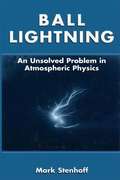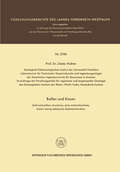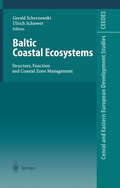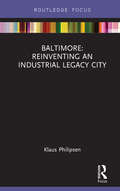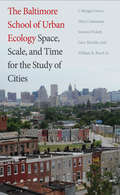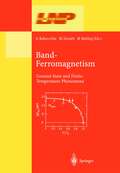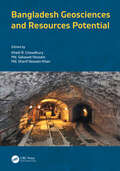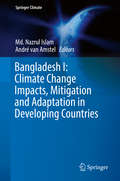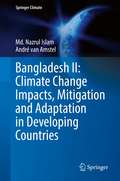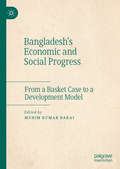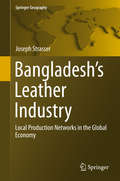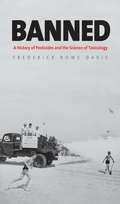- Table View
- List View
Balkanization and Global Politics: Remaking Cities and Architecture (Routledge Studies in Urbanism and the City)
by Nikolina BobicBalkanization (territorial fragmentation) is becoming a significant urban and geopolitical pursuit in contemporary times. Countries, cities and regions are ever increasingly voicing the desire for independence and balkanization from the nation or union they are a part of. This monograph generally maps the historical and theoretical emergence of balkanization, as well its more recent spread into fields as far ranging as law, medicine, data and security studies, sociology, architecture and the urban. The spatialization of balkanization is particularly addressed in terms of destruction and renewal through a detailed sociopolitical interrogation of architecture and the urban, including their changing symbolic, ideological and functional forms. The spatial connections between balkanization, violent remaking (destruction and renewal) and global politics have predominantly been analyzed via the former Yugoslav context and the Balkans, however, spotlight has also been directed to the current political climate of the UK, Australia and the Anglo-Saxon geopolitics. The analysis helps in understanding broader emergent patterns of sociospatial polarization across various scales, and in respect to global geoeconomic and geopolitical restructuring. This is particularly important because drawing connections between balkanization, economics, law, media and technology is to gain an awareness of - and engagement with - the emerging implications of spatial remaking and global politics. This monograph is a valuable resource and will be relevant to academics and students interested in spatial politics; including architecture, urbanism, geography, sociology, politics, international development, conflict, and cultural studies.
Ball Lightning: A Popular Guide to a Longstanding Mystery in Atmospheric Electricity
by Herbert BoernerBall lightning is an enigma. These luminous objects that appear occasionally during thunderstorms and can reach several meters in diameter have been a mystery to science for about 200 years. Despite several thousands of reported observations, their nature is still unknown. In this book, well documented cases of ball lightning are described and used to unravel some aspects of this mysterious form of atmospheric electricity. Throughout the book, the author discusses the various facets of the problem in an accessible but rigorous style, delivering a readable and informative text that will captivate the curious reader. He finally reaches the surprising conclusion that the solution to this puzzle may have been hidden in plain sight for many years. A foreword by Earle Williams, leading lightning researcher at MIT, introduces the book.
Ball Lightning: An Unsolved Problem in Atmospheric Physics
by Mark StenhoffDown comes a deluge of sonorous hail, Or prone-descending rain. Wide-rent, the clouds Pour a whole flood, and yet, its flame unquenched, Th’unconquerable lightning struggles through. Ragged and fierce, or in red whirling balls, And fires the mountains with redoubled rage. Black from the stroke, above, the smould’ring pine Stands a sad shattered trunk; and, stretched below, A lifeless group the blasted cattle lie. James Thompson, “The Seasons” (1727) have been investigating ball lightning for more than two decades. I published a ball lightning report in Nature in 1976 that received worldwide publicity and I consequently many people wrote to me with accounts of their own experiences. Within a very short time, I had accumulated about 200 firsthand accounts, and the file has continued to grow steadily since then. Several things impressed me. Few of those who wrote to me had any detailed foreknowledge of ball lightning at the time of their observation. Nonetheless, once reports of other phenomena such as St. Elmo’s fire had been eliminated, the remaining descriptions were remarkably consistent. Furthermore, nearly all who contacted me were keen to have an explanation of what they had seen and seemed entirely sincere.
Ball Lightning and Bead Lightning: Extreme Forms of Atmospheric Electricity
by James BarryThe purpose of this monograph is to review the known physical aspects of two unusual forms of atmospheric luminous phenomena, to deduce their characteristics and properties, and to promote efforts to improve their understanding. These two forms, called ball lightning and bead lightning, have visual images that differ from the linear image associated with normallightning. The terms "balliightning" and "bead lightning" are used to denote atmospheric luminous forms which are occasionally observed and have the geometrie shape suggested by their name. Vet, it is possible that neither phenomenon may in fact be a form of lightning in the sense of a continuous electrical discharge. Bead lightning has been described as the residue of a cloud-to cloud or cloud-to-ground lightning stroke and has the appearance of aseries of luminous balls separated by dark regions, thus resembling astring of pearls, and remains visible for about one second. Ball lightning has been described as a single luminous globe appearing ne ar the ground after a lightning stroke and also remaining visible for about one second. Both phenomena remain visible far longer than normal lightning flashes.
Ballast Water Treatment and Exchange for Ships (Synthesis Lectures on Ocean Systems Engineering)
by Alexander Olsen Pamela Rossi CiampoliniThe inadvertent transfer of harmful aquatic organisms and pathogens in the ballast water of ships has been determined to have caused a significant adverse impact to many of the world's coastal regions. The international maritime community, under the auspices of the IMO has developed several documents, including the “International Conventions for the Control and Management of Ship's Ballast Water and Sediments, 2004”, (Ballast Water Management Convention), which are aimed at preventing the introduction of unwanted aquatic organisms and pathogens through the discharge of ballast water and sediments. The Ballast Water Management Convention applies to vessels registered in a country which is party to the Convention and to those vessels registered in other countries when operating in the waters of a country which is party to the Convention. As a means to prevent, minimize and ultimately eliminate the risk to the environment, human health, property and resources arising from the transferof harmful aquatic organisms and pathogens through the control and management of vessel's ballast water and sediment, as well as to avoid unwanted side-effects from that control, the Convention requires vessels to conduct a ballast water exchange or be fitted with an approved ballast water management system. It is noted that several studies have shown that the effectiveness of ballast water exchange varies and is dependent on the vessel type (design), exchange method (sequential, flow-through and dilution methods), ballasting system configuration, exchange location, weather conditions and vessel's trading pattern. For these reasons (and others), it has been determined that ballast water exchange does not provide adequate protective measures to prevent damage from organisms and pathogens carried in a vessel's ballast, even though exchange was considered to be acceptable as an interim solution.This book includes updates for the clarification of Survey requirements and adds the definition of biological commissioning, testing as well as requirements for Class approved Service Providers to conduct biological commissioning testing. Moreover, this book includes updates due to the adoption of the requirements from IACS UR M74, Rev. 2 and UR F45 and is applicable for existing ships, where an application for approval for the plans of BWMS is made on or after 1 July 2022; or for new ships contracted for construction on or after 1 July 2022.
Ballen und Kissen: (ball-and-pillow structure), eine weitverbreitete, bisher wenig bekannte Sedimentstruktur (Forschungsberichte des Landes Nordrhein-Westfalen)
by Dieter RichterBaltic Coastal Ecosystems: Structure, Function and Coastal Zone Management (Central and Eastern European Development Studies (CEEDES))
by Gerald Schernewski, Ulrich SchiewerBetween November 20 and 23, 2000, the workshop "Baltic Coastal Ecosystems - Structure, Function and Coastal Zone Management" took place in Rostock, Ger many. The workshop was organised by the Institute of Aquatic Ecology of the University of Rostock and the Baltic Sea Research Institute Warnemiinde on be half of the Wissenschafts-Verbund Umwelt (WVU) at the University of Rostock. It was the third trans-disciplinary event that tried to link ecological and socio economical aspects with respect to the Baltic Sea. The first symposium was held in 1992, entitled "The Future of the Baltic Sea - Ecology, Economics, Administra tion and Teaching", and the second event took place in 1996, entitled "Sustainable Development in Coastal Regions - a Comparison Between North Atlantic Coast and Baltic Sea". The workshop "Baltic Coastal Ecosystems - Structure, Function and Coastal Zone Management" tried to provide an interdisciplinary forum for discussions, the exchange of ideas and the presentation of scientific results with respect to the Bal tic coast.
Baltic Region—The Region of Cooperation (Springer Proceedings in Earth and Environmental Sciences)
by Gennady Fedorov Alexander Druzhinin Elena Golubeva Dmitry Subetto Tadeusz PalmowskiThe Baltic macroregion is a platform for the development of different areas of international cooperation, which are an important factor affecting the socioeconomic growth of the region’s states. The deteriorating political relations between Russia and its Baltic neighbours complicate the development of mutual connections. However, economic and sociocultural cooperation and joint environmental projects continue despite all the difficulties. Based on recent studies carried out by Russian and Polish researchers, this book examines current trends in the socioeconomic development of the region’s countries and various forms of transboundary cooperation and provides recommendations for further development. Special attention is paid to sustainable environmental management and environmental protection, transboundary ties among companies and among people, the development of international tourism, opportunities for reinforcing the contact function of the border, and spatial planning. The book addresses theoretical problems that are of crucial significance to economic development and transboundary cooperation, namely, those of path dependence, the emerge.
The Baltic Sea Basin (Central and Eastern European Development Studies (CEEDES))
by Jan Harff, Svante Björck and Peer HothThis book reports about the results of a Special Symposium “The Baltic Sea Basin”, held on August 11, 2008, within the frame of the 33rd IGC at Oslo, Norway in order to foster the understanding of the Baltic Basin as a unit in terms of genesis, structure, ongoing processes and utilization. It is the first time that in a joint publication, scientists from different disciplines give a comprehensive overview about the Baltic Sea basin in such a general sense. The book will be used not only by students and scientist but also by engineers and decision makers from industry and politics. Summarizing the state of the art in the investigation of the Baltic Sea Basin, but also in the resource utilisation of the basin the book will enhance the development of new monitoring strategies and technical device design including satellite observation methods, the establishment of international research laboratories, innovative topics for interdisciplinary research projects, etc.
Baltimore: Reinventing an Industrial Legacy City (Built Environment City Studies)
by Klaus PhilipsenBaltimore: Reinventing an Industrial Legacy City is an exploration into the reinvention, self-reflection and boosterism of US legacy cities, taking Baltimore as the case study model to reveal the larger narrative. Author Klaus Philipsen investigates the modern urban condition and the systemic problems involved with adapting metropolitan regions into equitable and sustainable communities, covering topics such as growth, urban sprawl, the depletion of cities, social justice, smart city and open data, transportation, community development, sustainability and diversity. Baltimore’s proximity to the US capital, combined with its industrial past, presents the optimum viewpoint to investigate these challenges and draw parallels with cities across the world.
Baltimore: Reinventing an Industrial Legacy City (Built Environment City Studies)
by Klaus PhilipsenBaltimore: Reinventing an Industrial Legacy City is an exploration into the reinvention, self-reflection and boosterism of US legacy cities, taking Baltimore as the case study model to reveal the larger narrative. Author Klaus Philipsen investigates the modern urban condition and the systemic problems involved with adapting metropolitan regions into equitable and sustainable communities, covering topics such as growth, urban sprawl, the depletion of cities, social justice, smart city and open data, transportation, community development, sustainability and diversity. Baltimore’s proximity to the US capital, combined with its industrial past, presents the optimum viewpoint to investigate these challenges and draw parallels with cities across the world.
The Baltimore School of Urban Ecology: Space, Scale, and Time for the Study of Cities
by J. Morgan Grove Mary Cadenasso Steward T. Pickett Gary E. Machlis William R. BurchThe first “urban century” in history has arrived: a majority of the world’s population now resides in cities and their surrounding suburbs. Urban expansion marches on, and the planning and design of future cities requires attention to such diverse issues as human migration, public health, economic restructuring, water supply, climate and sea-level change, and much more. This important book draws on two decades of pioneering social and ecological studies in Baltimore to propose a new way to think about cities and their social, political, and ecological complexity that will apply in many different parts of the world. Readers will gain fresh perspectives on how to study, build, and manage cities in innovative and sustainable ways.
Bamboo Gridshells
by David RockwoodThis highly illustrated text brings together two areas which have both grown in popularity in recent years: gridshells and bamboo. Bamboo is a fast-growing, naturally available, renewable resource which is quite strong and lends itself to structural applications. In this unique text, David Rockwood demonstrates the viability of bamboo as a building material and considers the advantages – as well as the challenges – of working with bamboo. Its properties, workability, connections, assembly, erection processes, structural behavior, and final use are explored in detail through a series of design-build experiments and case studies from Hawai’i and Vietnam. The only book available on the subject, Bamboo Gridshells provides a comprehensive introduction to this emerging technology which will be of interest to anyone working in the areas of sustainable or environmental design, ecological construction, low technology strategies, or alternative materials.
Bamboo Gridshells
by David RockwoodThis highly illustrated text brings together two areas which have both grown in popularity in recent years: gridshells and bamboo. Bamboo is a fast-growing, naturally available, renewable resource which is quite strong and lends itself to structural applications. In this unique text, David Rockwood demonstrates the viability of bamboo as a building material and considers the advantages – as well as the challenges – of working with bamboo. Its properties, workability, connections, assembly, erection processes, structural behavior, and final use are explored in detail through a series of design-build experiments and case studies from Hawai’i and Vietnam. The only book available on the subject, Bamboo Gridshells provides a comprehensive introduction to this emerging technology which will be of interest to anyone working in the areas of sustainable or environmental design, ecological construction, low technology strategies, or alternative materials.
Banana Systems in the Humid Highlands of Sub-Saharan Africa: Enhancing Resilience and Productivity
by Idja Sikyolo Joseph Adheka Muller Kamira Francois Iradukunda Walter Ocimati Alex Barekye Emmanuel Njukwe Svetlana Gaidashova Edouard Rurangwa Deo Kantungeko Valentine Nakato Faustin Ngama Boloy Idd Ramathani Alex Rutikanga Charles Sivirihauma Laurence Jassogne Sam Mpiira Anne Rietveld Fenton Beed Emily Ouma William Tinzaara Nicolas Roux Michael Bolton David Turner‘Banana Systems in the Humid Highlands of Sub-Saharan Africa: Enhancing Resilience and Productivity’ addresses issues related to agricultural intensification in the (sub)humid highland areas of Africa, based on research carried out in the Great Lakes Region by the Consortium for Improving Agriculture-based Livelihoods in Central Africa.
Band-Ferromagnetism: Ground-State and Finite-Temperature Phenomena (Lecture Notes in Physics #580)
by K. Baberschke M. Donath W. NoltingThe fascinating phenomenon ferromagnetism is far from being fully understood, although it surely belongs to the oldest problems of solid state physics. For any investigation it appears recommendable to distinguish between materials whose spontaneous magnetization stems from localized electrons of a partially ?lled atomic shell and those in which it is due to itinerant electrons of a partially ?lled conduction band. In the latter case one speaks of band-ferromagnetism, prototypes of which are the classical ferromagnets Fe, Co, and Ni. The present book is a status report on the remarkable progress that has recently been made towards a microscopic understanding of band-ferromagnetism as an electron c- relation e?ect. The authors of the various chapters of this book “Band-Ferromagnetism: Ground-State and Finite-Temperature Phenomena” participated as selected - perts in the 242nd WE-Heraeus-Seminar (4-6 October 2000) held under almost the same title in Wandlitz near Berlin (Germany). It was the second seminar of this type in Wandlitz. (The ?rst in 1998 dealt with the complementary topic of the physics of local-moment ferromagnets such as Gd). Twenty-six invited spe- ers from ten di?erent countries together with ?fty-?ve further participants, who presented contributions in form of posters, spent three days together discussing in an enthusiastic and fertile manner the hot topics of band-ferromagnetism.
Bangladesh Geosciences and Resources Potential
by Khalil R. ChowdhuryThis book focuses on the potential natural resources of Bangladesh from Precambrian to recent times and their detailed geological background. Natural resources and their management are important for the sustainable economic development of a country. Focusing on the geological setting of the Bengal Basin, Bangladesh Geosciences and Resources Potential introduces and comprehensively describes the depositional environments, status and prospects of the potential natural resources of Bangladesh. Individual chapters outline the potential resources comprising a wide range of deposit types across the country. A selective overview of these natural resources—metallic minerals, coal, limestone, hydrocarbon, peat, placer deposits, surface, groundwater and so forth—is provided with relevant references. The book gives a synthesis of the issues in the mineral, hydrocarbon and water resource sectors from a resource-economic perspective. FEATURES Provides a geoscientific knowledge of the potential natural resources with relevant maps, figures and tables pertaining to the Bangladesh region Explains the resource-economic context, geomorphology and sustainable land use and the effects of climate change on both surface water and groundwater resources Discusses resource potentials based on systematic geological stages Presents the resources of renewable energy and discusses how to increase their use and effectiveness Reinforces basic geological processes and outcomes with an understanding of resource geology and constraints on natural resource management This book is aimed at researchers, graduate students and professionals in geology, energy and mineral resources, hydrogeology, water resources engineering, the environmental sciences and resource exploration and planning.
Bangladesh Geosciences and Resources Potential
by Khalil R. Chowdhury Sakawat Hossain Sharif Hossain KhanThis book focuses on the potential natural resources of Bangladesh from Precambrian to recent times and their detailed geological background. Natural resources and their management are important for the sustainable economic development of a country. Focusing on the geological setting of the Bengal Basin, Bangladesh Geosciences and Resources Potential introduces and comprehensively describes the depositional environments, status and prospects of the potential natural resources of Bangladesh. Individual chapters outline the potential resources comprising a wide range of deposit types across the country. A selective overview of these natural resources—metallic minerals, coal, limestone, hydrocarbon, peat, placer deposits, surface, groundwater and so forth—is provided with relevant references. The book gives a synthesis of the issues in the mineral, hydrocarbon and water resource sectors from a resource-economic perspective. FEATURES Provides a geoscientific knowledge of the potential natural resources with relevant maps, figures and tables pertaining to the Bangladesh region Explains the resource-economic context, geomorphology and sustainable land use and the effects of climate change on both surface water and groundwater resources Discusses resource potentials based on systematic geological stages Presents the resources of renewable energy and discusses how to increase their use and effectiveness Reinforces basic geological processes and outcomes with an understanding of resource geology and constraints on natural resource management This book is aimed at researchers, graduate students and professionals in geology, energy and mineral resources, hydrogeology, water resources engineering, the environmental sciences and resource exploration and planning.
Bangladesh I: Climate Change Impacts, Mitigation and Adaptation in Developing Countries (Springer Climate)
by André Van Amstel Md. Nazrul IslamThe aim of this book is to provide information to scientists and local government to help them better understand the particularities of the local climate. Climate change is one of the biggest challenges to society. It can lead to serious impacts on production, life and environment on a global scale. Higher temperatures and sea level rise will cause flooding and water salinity problems which bring about negative effects on agriculture and high risks to industry and socio-economic systems in the future. Climate change leads to many changes in global development and security, especially energy, water, food, society, job, diplomacy, culture, economy and trade. The Intergovernmental Panel on Climate Change (IPCC) defines climate change as: “Any change in climate over time, whether due to natural variability or as a result of human activity.” Global climate change has emerged as a key issue in both political and economic arenas. It is an increasingly questioned phenomenon, and progressive national governments around the world have started taking action to respond to these environmental concerns.
Bangladesh II: Climate Change Impacts, Mitigation and Adaptation in Developing Countries (Springer Climate)
by Md. Nazrul Islam André van AmstelThis volume aims to develop a framework for disaster and climate risk resilient livelihood system in Bangladesh using a policy oriented approach. It highlights the possible impacts of climate change on groundwater based irrigation in the country. Climate change is one of biggest challenges to society. It can lead to serious impacts on production, life and environment on a global scale. Higher temperatures and sea level rise will cause flooding and water salinity problems which will bring about negative effects on agriculture and high risks to industry and socio-economic systems in the future. Climate change will lead to many changes in global development and security especially energy, water, food, society, job, diplomacy, culture, economy and trade. The Intergovernmental Panel on Climate Change (IPCC) defines climate change as: “Any change in climate over time, whether due to natural variability or as a result of human activity.” Global climate change has emerged as a key issue in both political and economic arenas. It is an increasingly questioned phenomenon, and progressive national governments around the world have started taking action to respond to these environmental concerns.
Bangladesh's Economic and Social Progress: From a Basket Case to a Development Model
by Munim Kumar BaraiThis book evaluates Bangladesh’s impressive economic and social progress, more often referred to as a ‘development surprise’. In doing so, the book examines the gap in existing explanations of Bangladesh’s development and then offers an empirically informed analysis of a range of distinctive factors, policies, and actions that have individually and collectively contributed to the progress of Bangladesh. In an inclusive way, the book covers the developmental role, relation, and impact of poverty reduction, access to finance, progress in education and social empowerment, reduction in the climatic vulnerability, and evolving sectoral growth activities in the agriculture, garments, and light industries. It also takes into account the important role of the government and NGOs in the development process, identifies bottlenecks and challenges to Bangladesh’s future development path and suggests measures to overcome them.By providing an inclusive narrative to theorize Bangladesh’s development, which is still missing in the public discourse, this book posits that Bangladesh per se can offer a development model to other developing countries.
Bangladesh's Leather Industry: Local Production Networks in the Global Economy (Springer Geography)
by Joseph StrasserThis study provides an overview of how the Bangladeshi leather value chain is organised and governed. It analyses how the leather processing and leather goods/footwear subsectors are integrated into the global market and to what extent informal arrangements including illicit practices are conducive to global market entry. Power relations are dissected along the value chain, in order to analyse how local producers adapt to upholding competitiveness. The results of the work show the need to devise upgrading strategies which pay heed to the reality of informal dynamics in a global value chain (GVC) to improve the local producers’ competitiveness. The GVC perspective was combined with considerations on upgrading, subcontracting, middlemen and informality to adequately analyse the complexity of the transactions in the chain. The data of this study are drawn from empirical field studies in Dhaka, Bangladesh and other sections of the international leather value chain during the time period of 2010 to 2014. A qualitative research approach was complemented with quantitative methods.
Banking Reforms in Africa: Implications for Economic Welfare and Poverty Reduction (Routledge International Studies in Money and Banking)
by Agnes Olatokunbo MartinsThis book comprehensively explores the intricate relationship between banking reforms, economic well-being, and poverty reduction across the African continent. Delving into the historical roots of banking reforms, it examines the resilience of banking sectors in key African countries like South Africa, Nigeria, Kenya, MENA, and beyond.The findings suggest that much attention should be paid to the design of banking systems and how banks are regulated. This focus on banks differs from many discussions on the topic, which tend to be more concerned with other policy areas such as economic policy, international trade policy, and aid. The book’s extensive and contemporary overview of banking reforms enables a comparative analysis of regulatory frameworks, supervision practices, and government interventions. It evaluates theoretical frameworks linking banking reforms to bank stability and resilience, drawing on financial intermediation, resource allocation, systemic risk, and financial development concepts. It empirically tests the causal relationships between the Basel II/III capital reforms, bank sector resilience, economic growth, and poverty reduction and identifies and analyses the channels and mechanisms through which banking reforms affect economic welfare and poverty reduction in Africa, such as credit availability, financial efficiency, financial innovation, and financial access.The book offers an insightful exploration into a brighter economic future on the African continent. The findings presented herein offer valuable insights for policymakers, researchers, and practitioners striving to enhance financial stability, foster economic growth, and alleviate poverty in Africa.
Banking Reforms in Africa: Implications for Economic Welfare and Poverty Reduction (Routledge International Studies in Money and Banking)
by Agnes Olatokunbo MartinsThis book comprehensively explores the intricate relationship between banking reforms, economic well-being, and poverty reduction across the African continent. Delving into the historical roots of banking reforms, it examines the resilience of banking sectors in key African countries like South Africa, Nigeria, Kenya, MENA, and beyond.The findings suggest that much attention should be paid to the design of banking systems and how banks are regulated. This focus on banks differs from many discussions on the topic, which tend to be more concerned with other policy areas such as economic policy, international trade policy, and aid. The book’s extensive and contemporary overview of banking reforms enables a comparative analysis of regulatory frameworks, supervision practices, and government interventions. It evaluates theoretical frameworks linking banking reforms to bank stability and resilience, drawing on financial intermediation, resource allocation, systemic risk, and financial development concepts. It empirically tests the causal relationships between the Basel II/III capital reforms, bank sector resilience, economic growth, and poverty reduction and identifies and analyses the channels and mechanisms through which banking reforms affect economic welfare and poverty reduction in Africa, such as credit availability, financial efficiency, financial innovation, and financial access.The book offers an insightful exploration into a brighter economic future on the African continent. The findings presented herein offer valuable insights for policymakers, researchers, and practitioners striving to enhance financial stability, foster economic growth, and alleviate poverty in Africa.
Banned: A History of Pesticides and the Science of Toxicology
by Frederick Rowe DavisRachel Carson’s eloquent book Silent Spring stands as one of the most important books of the twentieth century and inspired important and long-lasting changes in environmental science and government policy. Frederick Rowe Davis thoughtfully sets Carson’s study in the context of the twentieth century, reconsiders her achievement, and analyzes its legacy in light of toxic chemical use and regulation today. Davis examines the history of pesticide development alongside the evolution of the science of toxicology and tracks legislation governing exposure to chemicals across the twentieth century. He affirms the brilliance of Carson’s careful scientific interpretations drawing on data from university and government toxicologists. Although Silent Spring instigated legislation that successfully terminated DDT use, other warnings were ignored. Ironically, we replaced one poison with even more toxic ones. Davis concludes that we urgently need new thinking about how we evaluate and regulate pesticides in accounting for their ecological and human toll.


